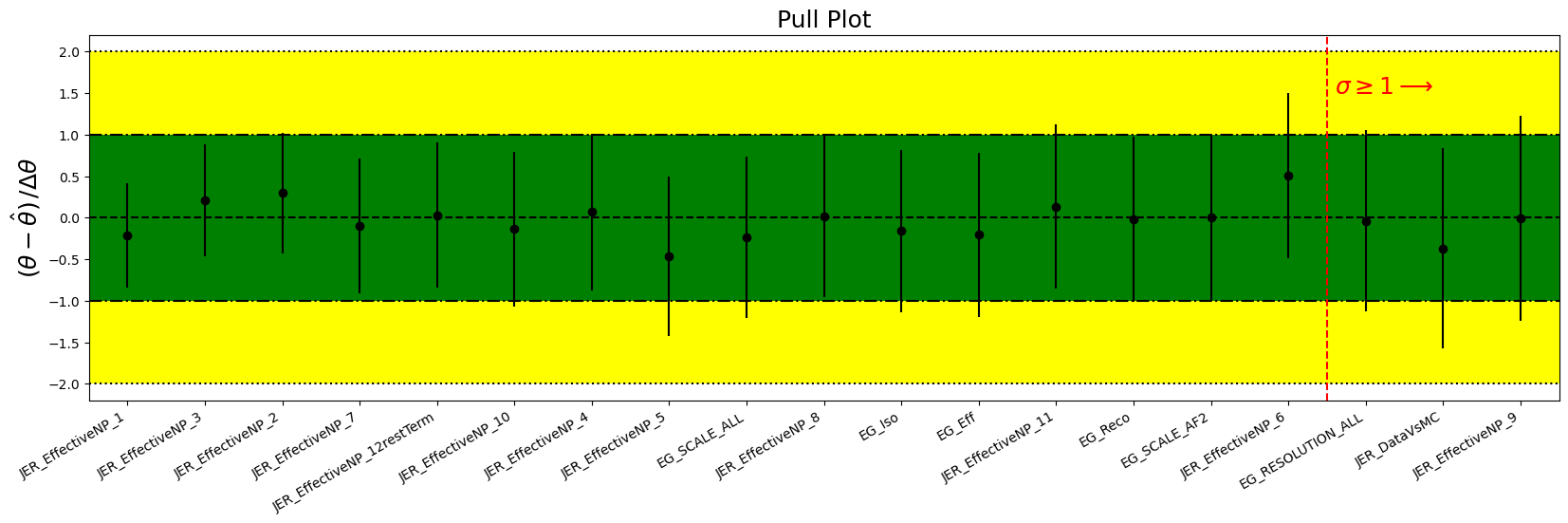Making a Pull Plot#
Let’s use a background-only workspace that we’ve bundled with the tutorial. It’s a little bit more complicated than the simple workspace we’ve seen in the past, but it will be a bit easier to demonstrate the efficacy of pulls this way.
Loading the workspace#
import json
import matplotlib.pyplot as plt
import matplotlib.ticker as mticker
import numpy as np
import pyhf
with open("data/bkg_only.json") as serialized:
spec = json.load(serialized)
workspace = pyhf.Workspace(spec)
Model and Data#
model = workspace.model(poi_name=None) # background-only!
data = workspace.data(model)
Making a Pull Plot#
We need to use minuit in order to perform the fits. So first we’ll set our backends to use numpy and minuit. Then we’ll do a bunch of setup to make it easier to compute the pulls. Work is on-going in pyhf to streamline this a bit more and put it into pyhf.contrib.
Unlike the scipy optimizer, minuit provides the uncertainties on the parameters which we need for the pulls.
print(f"Tensor Lib: {pyhf.tensorlib}")
print(f"Optimizer: {pyhf.optimizer}")
Tensor Lib: <pyhf.tensor.numpy_backend.numpy_backend object at 0x7f4bade63700>
Optimizer: <pyhf.optimize.scipy_optimizer object at 0x7f4bd42f37e0>
pyhf.set_backend("numpy", "minuit")
print(f"Tensor Lib: {pyhf.tensorlib}")
print(f"Optimizer: {pyhf.optimizer}")
Tensor Lib: <pyhf.tensor.numpy_backend.numpy_backend object at 0x7f4babafcdc0>
Optimizer: <pyhf.optimize.minuit_optimizer object at 0x7f4babb03640>
Note: one really nice feature that we love about the backend switching is you can also customize the backends instead of using a default config… such as changing the tolerance.
pyhf.optimizer.tolerance
0.1
pyhf.set_backend(pyhf.tensorlib, pyhf.optimize.minuit_optimizer(tolerance=1e-3))
print(f"Tensor Lib: {pyhf.tensorlib}")
print(f"Optimizer: {pyhf.optimizer}")
print(f"Tolerance: {pyhf.optimizer.tolerance}")
Tensor Lib: <pyhf.tensor.numpy_backend.numpy_backend object at 0x7f4babafcdc0>
Optimizer: <pyhf.optimize.minuit_optimizer object at 0x7f4babb9de40>
Tolerance: 0.001
Performing the Fit#
In the past, we’ve done a hypothesis test which does multiple fits, both constrained and unconstrained fits. Instead, we will need to perform an unconstrained fit on the background in order to determine the fluctuation of all the parameters and the corresponding pulls.
result = pyhf.infer.mle.fit(data, model, return_uncertainties=True)
With return_uncertainties=True, we return, instead of just a 1-dimensional vector of the fitted parameter values, a 2-dimensional vector including the fitted parameter uncertainties as well.
result[:5]
array([[-0.20352883, 0.98834153],
[-0.16148808, 0.97923014],
[-0.03847847, 1.08849139],
[-0.02117255, 0.99276658],
[ 0. , 0.99334679]])
So let’s split this up to handle.
bestfit, errors = result.T
Normalize to natural width#
Now we need to compute the pulls. In order to do so, we need to determine the constrained parameters of the model. We can do this by looping over the ordered parameters of the model. pyhf maintains a particular order of the parameters as we load them up into a large tensor in a specific order. So we can access this same order of the fitted parameters to the parameter names using pyhf.Model.config.par_order:
model.config.par_order
['EG_Eff',
'EG_Iso',
'EG_RESOLUTION_ALL',
'EG_Reco',
'EG_SCALE_AF2',
'EG_SCALE_ALL',
'JER_DataVsMC',
'JER_EffectiveNP_1',
'JER_EffectiveNP_10',
'JER_EffectiveNP_11',
'JER_EffectiveNP_12restTerm',
'JER_EffectiveNP_2',
'JER_EffectiveNP_3',
'JER_EffectiveNP_4',
'JER_EffectiveNP_5',
'JER_EffectiveNP_6',
'JER_EffectiveNP_7',
'JER_EffectiveNP_8',
'JER_EffectiveNP_9']
So first, we’ll compute the pulls. This is done by calculating the difference between the fitted parameter value, the initial value, and divide by the width of that constrained parameter
pulls = pyhf.tensorlib.concatenate(
[
(bestfit[model.config.par_slice(k)] - model.config.param_set(k).suggested_init)
/ model.config.param_set(k).width()
for k in model.config.par_order
if model.config.param_set(k).constrained
]
)
We can also do this similarly for the error on the parameter as well:
pullerr = pyhf.tensorlib.concatenate(
[
errors[model.config.par_slice(k)] / model.config.param_set(k).width()
for k in model.config.par_order
if model.config.param_set(k).constrained
]
)
Finally, we just need to create a set of labels for the parameters that were constrained that we are showing pulls for.
labels = np.asarray(
[
f"{k}[{i}]" if model.config.param_set(k).n_parameters > 1 else k
for k in model.config.par_order
if model.config.param_set(k).constrained
for i in range(model.config.param_set(k).n_parameters)
]
)
Order Results#
Now we need to sort the labels in order of the uncertainty to make things easier to digest. We’ll figure out the sort order we need using np.argsort and apply that ordering to everything we’ve created.
_order = np.argsort(errors)
bestfit = bestfit[_order]
errors = errors[_order]
labels = labels[_order]
pulls = pulls[_order]
pullerr = pullerr[_order]
Plotting Results#
Now we can finally make a plot to appease our supervisor!
fig, ax = plt.subplots()
fig.set_size_inches(20, 5)
# set up axes labeling, ranges, etc...
ax.xaxis.set_major_locator(mticker.FixedLocator(np.arange(labels.size).tolist()))
ax.set_xticklabels(labels, rotation=30, ha="right")
ax.set_xlim(-0.5, len(pulls) - 0.5)
ax.set_title("Pull Plot", fontsize=18)
ax.set_ylabel(r"$(\theta - \hat{\theta})\,/ \Delta \theta$", fontsize=18)
# draw the +/- 2.0 horizontal lines
ax.hlines([-2, 2], -0.5, len(pulls) - 0.5, colors="black", linestyles="dotted")
# draw the +/- 1.0 horizontal lines
ax.hlines([-1, 1], -0.5, len(pulls) - 0.5, colors="black", linestyles="dashdot")
# draw the +/- 2.0 sigma band
ax.fill_between([-0.5, len(pulls) - 0.5], [-2, -2], [2, 2], facecolor="yellow")
# drawe the +/- 1.0 sigma band
ax.fill_between([-0.5, len(pulls) - 0.5], [-1, -1], [1, 1], facecolor="green")
# draw a horizontal line at pull=0.0
ax.hlines([0], -0.5, len(pulls) - 0.5, colors="black", linestyles="dashed")
# finally draw the pulls
ax.scatter(range(len(pulls)), pulls, color="black")
# and their uncertainties
ax.errorbar(
range(len(pulls)),
pulls,
color="black",
xerr=0,
yerr=pullerr,
marker=".",
fmt="none",
)
# error > 1
error_gt1 = np.argmax(errors > 1) - 0.5
ax.axvline(x=error_gt1, color="red", linestyle="--")
ax.text(
error_gt1 + 0.1, 1.5, r"$\sigma \geq 1 \longrightarrow$", color="red", fontsize=18
);


